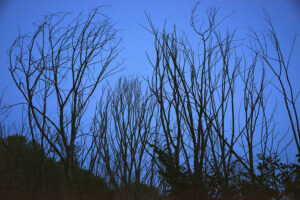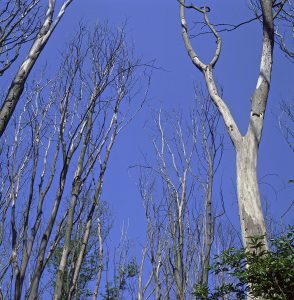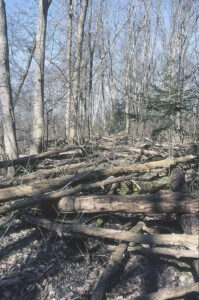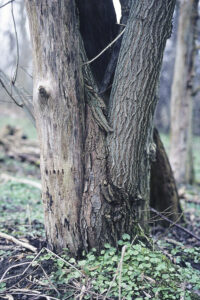Dutch elm disease on Vorsø
In the silent summer night, these common elms (Ulmus glabra), which have been killed by Dutch elm disease, tower towards the sky. – Vorsø, July 31, 2015. (Photo copyright © by Kaj Halberg)
Dutch elm disease attacks various species of elm (Ulmus), in Europe especially common elm (U. glabra), in North America predominantly American elm (U. americana). This disease is caused by sac fungi, belonging to the genus Ophiostoma (formerly called Ceratocystis). These fungi are natives of Asia, where local elm species are resistant to the disease. However, this is not the case in Europe and North America, where the disease is epidemic.
In Europe, Dutch elm disease was first noted in 1910, transmitted by the species Ophiostoma ulmi, which reached North America on imported timber in 1928. A second, extremely virulent species from Japan, O. novo-ulmi, was present in Europe and North America from the 1960s.
Transmitted by beetles
The spores of these fungi are transmitted to the elms by bark beetles, belonging to the genus Scolytus, in America also the genus Hylurgopinus. In Denmark, two species of these beetles occur, large elm bark beetle (Scolytus scolytus) and small elm bark beetle (S. laevis). These beetles live in the treetops, and if they land on an elm, which is infected with Dutch elm disease, the spores of the fungus attach to the beetles during their feeding.
When females are about to lay eggs, they creep down to the trunk, or a larger branch, in which they gnaw into the soft layer between the bark and the wood, where they produce an egg-laying tunnel. When the eggs hatch, the larvae gnaw long feeding tunnels, which create beautiful patterns in the wood. When the female has laid eggs, she will seek out other elms, hereby spreading the spores of the fungus. Almost all elms, which are infected with the disease, die within one year.
From the egg-laying tunnel, the hatched larvae gnaw long feeding tunnels, which create beautiful patterns in the wood. – October 29, 1988. (Photo copyright © by Kaj Halberg)
The first sign to indicate that an elm has been attacked by Dutch elm disease is that its leaves begin to turn yellow already in summer. – June 30, 2006. (Photo copyright © by Kaj Halberg)
Elm disease on Vorsø
The elms on Vorsø were attacked by the disease around 1980, and as early as the 1990s, all larger elms on the island had died. In Østerskov (the old eastern forest), where elm had been a dominating tree, creating a dense foliage cover, the wood mass of this species was reduced by 99.5% during a few years in the 1980s.
This did not mean, however, that elm was eradicated from the island. As adult bark beetles live in the upper stratum of the forest, the elms must be of a certain height, before the beetles can find them. But when young elms start to tower over the surrounding trees and bushes, they are invariably attacked by the disease and die.
On Vorsø, the elms now began to flower and bear fruit at a much younger age than was the case, when the elms grew large on the island. This means that the pool of seeds is constantly renewed, and as soon as the elms are attacked and die, new elms shoot up. Some of the affected elms are able to sprout again from the root, but are killed again when they reach a certain height.
The elms on Vorsø were attacked by Dutch elm disease around 1980, and as early as the 1990s, all larger elms on the island had died. This picture shows an area in the central part of the old western forest, Vesterskov. – May 20, 1993. (Photo copyright © by Kaj Halberg)
Same part of Vesterskov as in the previous picture, 2004. Most of the dead elms have already toppled, creating a glade, dominated by ash (Fraxinus excelsior). A few small common firs (Abies alba) also benefit from the increased amount of light. – March 30, 2004. (Photo copyright © by Kaj Halberg)
When young elms begin towering over the surrounding trees and bushes, they are invariably attacked by the disease and die. To the right an elm, which has recently been attacked by the disease. The reddish leaves are of a spindle-tree (Euonymus europaeus). – September 10, 2013. (Photo copyright © by Kaj Halberg)
Some of the affected elms are able to sprout again from the root, but are killed again when they reach a certain height. – March 27, 2004. (Photo copyright © by Kaj Halberg)
(Uploaded February 2017)
(Latest update July 2021)








